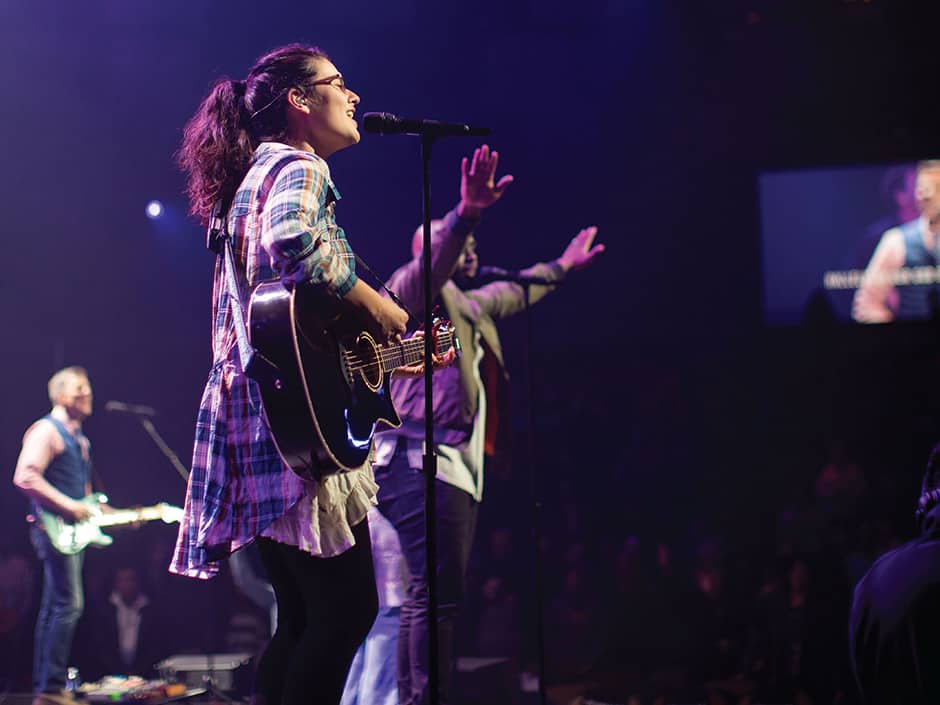Courageous Congregational Singing

The belief that a congregation might sing in a courageous manner was suggested first, as far as I know, by one of the world’s great preachers, John Wesley (thus the interest for pastors). In his “Directions for Singing” in Select Hymns (1761), he advises congregations to “sing lustily and with a good courage.” In point V, he also suggests that congregational singers should sing “modestly,” by which he meant that singers should not be bawling out the tune so as to be heard above others!
It was not Wesley, however, who inspired me along these lines, but rather an experience while on the road. I attended several worship services, including one at a church it would be fair to label as “evangelical.” It was a large church (more than 1,500 average weekly attendance), and the worship space is in a large, dark venue with no windows whatsoever, and lit up with colored lights. The prototypical worship band was up front and on stage, the drummer was ensconced behind Plexiglas, and they led the congregation in 10-minute praise sets with all of us standing, and the words to the music, rather than being in a hymnal, were on a screen.
I didn’t know the tunes to most of the songs, and there was this one song that was quite unsingable. The melody was all over the place and no one else seemed to know it either. Fortunately, the band knew it well because they were belting it out in quite a lusty and courageous manner, and not at all modestly, at least not in the Wesleyan sense of the word.
I looked around. I knew I wasn’t singing with lust or any of the other seven deadly sins, and with none of the cardinal virtues either. And I couldn’t see very many others who were … I was in good company. A few people were lip-syncing, while the singers on stage provided the audio. This congregation was in no danger of violating Wesley’s rule No. V. It was very modest singing — nothing daring, risqué, courageous, or lusty about it.
Truth is, I’ve heard better singing at a funeral.
I’ve heard better singing in the shower.
I’ve heard better singing at a Cubs game.
I’ve heard better singing in a bar after a Cubs game.
This experience led me to wonder if I might safely offer a sweeping generalization, i.e. that lusty and courageous congregational singing is on the decline. You may disagree.
This generalization isn’t limited to churches with a worship band. I’ve found the same level of modest caroling in high steeple churches as well, especially those with a four-manual pipe organ — which is really just a rich person’s worship band when you think about it. The organ, rather than the band, is the performance instrument, and even if some singing is taking place, you’re not likely to hear much beyond the sound of your own voice because the juiced-up organist is flying over those keyboards and doing an Irish Riverdance on the pedals like his feet are on fire.
While studying this question, I consulted several theologians, worship leaders and pastors. One seminary professor told me that it’s not just congregational singing that’s in decline, but singing in general. A pastor wonders where “people gather to sing together in our culture anymore unless it’s a ballgame or a karaoke bar.” We used to gather around a piano and sing. We used to have “Singspirations,” but today “with MP3 players and playlists, we purchase music, evaluate it, rate it, own it, but we don’t sing it.” Stan Purdum, editor of our sister publication The Wired Word, recalls his childhood in the Salvation Army: “We didn’t usually sing prayer choruses lustily, but the services sometimes ended up with ‘hallelujah windups,’ with lusty singing, clapping and marching around the worship area.”
Hallelujah windups! I tell you what: I’ve got to find a way to introduce this to my church! “Brothers and sisters, we’re going to conclude our worship today (or begin our worship) with a hallelujah windup.” That is so awesome!
Another pastor noted that “the Wesley brothers used hymn-singing as a way of inculcating Methodist theology into the lives of the common people.” In that sense, hymns were sort of the Protestant version of the cathedral stained-glass window. “The hymns of John and Charles Wesley are deep theologically,” he says, “and not as vapid as some contemporary church music.”
This isn’t to say one can’t find a lusty and courageous pocket of praise somewhere. It still exists in certain churches here and there in all traditions — Church of Christ (non-instrumental), Mennonite, Baptist, mainline, African-American, evangelical and so on. But generally, it seems to me that we’re not doing enough to encourage congregational singing.
What can we do? It’s a hot-button topic, but one theologian notes that “people sing the loudest on the most popular radio songs, meaning that … song repetition and familiarity could be key in our churches.”
Another pastor says that we might also revisit and reinvigorate the forgotten idea of the congregation as the “true choir” of the church. At some point in its history, he notes, the Presbyterian Book of Order mentions this. So what happened?
Seems to me that Christianity is a singing faith. I dare say there’s no religion in the world with a history of hymnody and a corpus of carols as vast as Christianity. It’s what Christians do! Why not let us do it? And is it not true that most average folk would rather be a part of a congregation that’s singing courageously and lustily instead of standing mute, listening to a few who sing loudly and immodestly?
Worship leader Anne Griffin gets it when she says, “My goal each week is to create space for freedom in worship, i.e. freedom to sing, to listen (and not sing), to dance, to sit, to kneel, to shout … to respond to God in a way that demonstrates our true love for God.”
Yes! This is not a call to remove worship bands or pipe organs. It’s simply a call to set the people free. Let the people sing! Hallelujah!
Share this Post:
Looking for More?
Imagine having fresh help in preparing your sermons right at your fingertips, especially during those weeks when your words and ideas are not flowing easily. Homiletics Online won’t write the sermon for you but once you’ve used this treasury of solid content, you’ll wonder how you ever got along without it.
Would you like to see your post on this blog?
We are always looking for talented and passionate writers who want to share their ideas on preaching the Gospel. If that sounds like you, then please use the button to submit a guest post.

